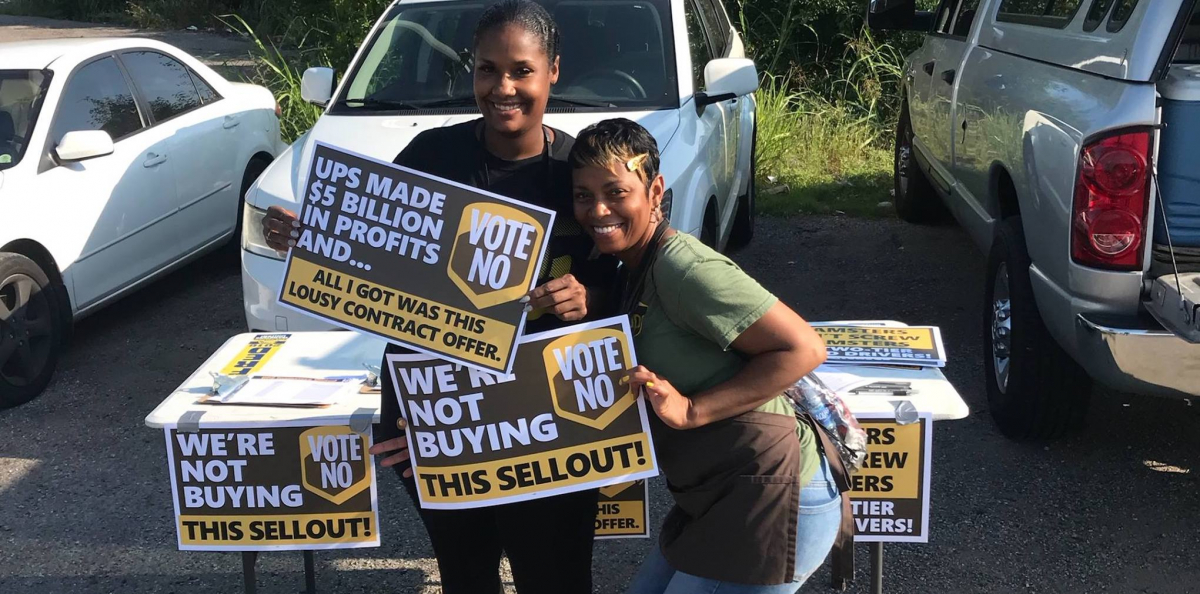Vote No Sentiment Escalating at UPS

The “vote no” movement at UPS looks bigger than ever. Credit: Teamsters United
The movement for a no vote keeps growing at UPS.
Each UPS local sent two leaders to the union’s “two-person meeting” August 9 to hear the international union’s sales pitch and decide whether to recommend the agreement to the 270,000 affected members.
It’s typically a rubber-stamping, but this time local leaders had a lot of questions and criticisms. In a voice vote, roughly a third voted against recommending the deal.
Days later, 5,000 people joined a UPS Teamsters United “vote no” conference call to discuss the ins and outs of the tentative agreement and how they’re spreading the word.
When will members get their chance to vote? The date isn’t set yet, but union tops indicated they’re aiming for a mid-September start to electronic voting, with the count in October.
TOOTH AND NAIL
Delivery drivers’ top complaint is that the deal would allow UPS to create a second tier of “hybrid drivers” who could deliver packages at a much lower wage. That’s the deal-breaker for 20-year driver Eugene Braswell. As far as he’s concerned, it’s unfair to have workers “doing the exact same thing that I’m doing, for less money.”
And in the long run, he believes selling out future hires will tear the union apart. Someday he’ll be a retiree, he said, and disgruntled hybrid drivers could be the ones deciding whether or not to safeguard his pension.
He’s been comparing notes with his friend Vinnie, a shop steward at the post office, about how the letter carriers union has suffered since an arbitrator imposed a second tier in 2013. “They have the casuals working for less money, and they’ve got no unity at all,” Braswell said. “We’ve got to fight that tooth and nail.”
To get the word out, Braswell and others from Local 804 have been leafleting at workplace gates in New York. They also hit the road to visit four buildings in New Jersey, Philadelphia, and Baltimore—the home local of negotiator Denis Taylor. Even there, Braswell met Teamsters who are pumped up to vote no. The deal isn’t popular with inside workers who sort, load, and unload packages either. It fails to combine part-time jobs into full-time ones and lacks a significant raise for the current workforce.
WORST FREIGHT DEAL EVER
Meanwhile, details are out on the agreement covering 12,000 workers at UPS Freight, and it’s not pretty. “We had one job,” said Oregon Teamsters Local 206 Representative Leonard Stoehr.
The union had a mandate from members to eliminate subcontracting—and its original proposal would have done just that. “I took that back to the members and they were stoked,” Stoehr said.

SUPPORT LABOR NOTES
BECOME A MONTHLY DONOR
Give $10 a month or more and get our "Fight the Boss, Build the Union" T-shirt.
But the actual tentative agreement revealed in August is far different. The subcontracted share of UPS freight volume would decrease from 21.9 percent to 17.9 percent over the five-year contract.
If the industry keeps growing at its current pace, Stoehr points out, that would allow a net increase in the tons of freight hauled by subcontractors.
UPS Freight is in the business of less-than-truckload shipping, where a single truck carries palletized freight for two or more customers; shipments vary from 200 to 20,000 pounds. Its biggest competitors are nonunion, along with major unionized carriers YRC and ABF. As union density has plummeted in the sector, so have contract standards for the remaining Teamsters.
Drivers see the writing on the wall—UPS Freight has every incentive to replace them with lower-paid, subcontracted workers. Already the employer gets away with subcontracting while union members are out on layoff.
The raises are measly, too. Each year drivers would get a boost of a quarter-cent per mile.
WHY AGREE TO THIS?
Why would anyone sign off on this? At press time the Teamsters communications department had not responded to Labor Notes’ request for an interview. Reportedly the union’s pitch is that UPSers must accept a weak deal because UPS Freight could be closed down entirely.
But Stoehr believes that’s unlikely. Freight is just one arm of UPS, which is forecasting $6 billion in profit this year. Offering a comprehensive array of shipping services is part of its overall strategy. Rival FedEx is in the less-than-truckload business too.
“Both want to establish themselves as one-stop shopping for a shipper,” Stoehr said. “If you have a truckload, they can handle that, or less-than-truckload, or a package or an envelope. It’s a matter of convenience for high-volume shippers like Amazon.
“I fail to see how they would even conceivably just concede the less-than-truckload sector to their main competitor.”
In 2013, the UPS Freight deal was rejected 2 to 1. But local leaders pushed the message, “You’ll have to go on strike,” and got it approved in a revote. The UPS package contract passed narrowly, but repeated rejections of its regional supplements held up the whole thing for months, until President James Hoffa imposed three of the supplements unilaterally.
This time, the “vote no” movement looks bigger than ever. Activists like Braswell are determined to send bargainers back to the table to improve the deal. “From the time I came in,” he said, “they told me you’re supposed to leave your union stronger than the way you found it.”






